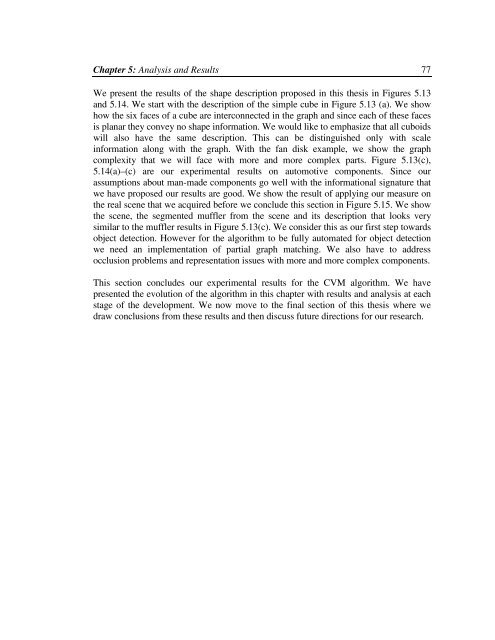To the Graduate Council: I am submitting herewith a thesis written by ...
To the Graduate Council: I am submitting herewith a thesis written by ...
To the Graduate Council: I am submitting herewith a thesis written by ...
You also want an ePaper? Increase the reach of your titles
YUMPU automatically turns print PDFs into web optimized ePapers that Google loves.
Chapter 5: Analysis and Results 77We present <strong>the</strong> results of <strong>the</strong> shape description proposed in this <strong>the</strong>sis in Figures 5.13and 5.14. We start with <strong>the</strong> description of <strong>the</strong> simple cube in Figure 5.13 (a). We showhow <strong>the</strong> six faces of a cube are interconnected in <strong>the</strong> graph and since each of <strong>the</strong>se facesis planar <strong>the</strong>y convey no shape information. We would like to emphasize that all cuboidswill also have <strong>the</strong> s<strong>am</strong>e description. This can be distinguished only with scaleinformation along with <strong>the</strong> graph. With <strong>the</strong> fan disk ex<strong>am</strong>ple, we show <strong>the</strong> graphcomplexity that we will face with more and more complex parts. Figure 5.13(c),5.14(a)–(c) are our experimental results on automotive components. Since ourassumptions about man-made components go well with <strong>the</strong> informational signature thatwe have proposed our results are good. We show <strong>the</strong> result of applying our measure on<strong>the</strong> real scene that we acquired before we conclude this section in Figure 5.15. We show<strong>the</strong> scene, <strong>the</strong> segmented muffler from <strong>the</strong> scene and its description that looks verysimilar to <strong>the</strong> muffler results in Figure 5.13(c). We consider this as our first step towardsobject detection. However for <strong>the</strong> algorithm to be fully automated for object detectionwe need an implementation of partial graph matching. We also have to addressocclusion problems and representation issues with more and more complex components.This section concludes our experimental results for <strong>the</strong> CVM algorithm. We havepresented <strong>the</strong> evolution of <strong>the</strong> algorithm in this chapter with results and analysis at eachstage of <strong>the</strong> development. We now move to <strong>the</strong> final section of this <strong>the</strong>sis where wedraw conclusions from <strong>the</strong>se results and <strong>the</strong>n discuss future directions for our research.
















